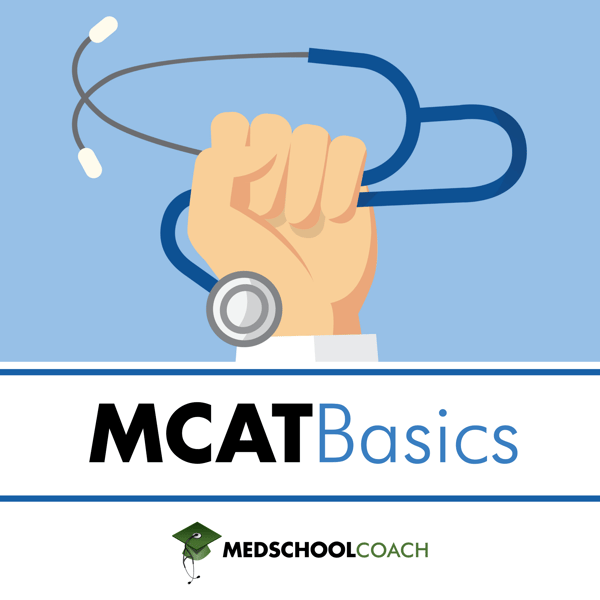Biosignaling
MCAT Basics (from MedSchoolCoach)
MedSchoolCoach
4.6 • 612 Ratings
🗓️ 19 June 2025
⏱️ 26 minutes
🧾️ Download transcript
Summary
In this episode, we focus on biosignaling and cover how cells communicate through systems like voltage-gated and ligand-gated ion channels, using real-world examples such as neuronal signaling and muscle contraction.
We also break down the role of enzyme-linked receptors, specifically receptor tyrosine kinases (RTKs), and explore how these pathways are involved in cell growth and cancer. Additionally, we take a detailed look at G-protein coupled receptors (GPCRs) and their role in activating secondary messenger systems like cyclic AMP (cAMP).
Visit MedSchoolCoach.com for more help with the MCAT.
Jump into the conversation:
(00:00) Intro
(00:32) Overview of Biosignaling
(01:05) Introduction to Biosignaling and its Importance
(01:49) Stimulus-Response Concept: Fight or flight, glucose homeostasis, transcription regulation
(02:34) Voltage-Gated Ion Channels: Activated by changes in membrane potential
(03:29) Action Potential: Sodium channels and signal propagation
(05:01) Ligand-Gated Ion Channels: Role in neuron-to-neuron signaling
(06:01) Muscle Contraction: Acetylcholine's role in skeletal muscle contraction
(07:29) Misconception on Calcium: Sodium initiates muscle cell depolarization, not calcium
(08:33) Enzyme-Linked Receptors: Focus on receptor tyrosine kinases (RTKs)
(09:39) RTKs and Cancer: How RTK signaling pathways are linked to cancer
(12:00) G-Protein Coupled Receptors (GPCR): Structure and function of GPCRs
(14:43) Adenylate Cyclase and cAMP: Role of GTP in activating adenylate cyclase and producing cAMP
(18:10) Quiz Question 1: Ion specificity in potassium channels
(22:54) Quiz Question 2: Hypertension treatment and G-protein pathways
(25:00) Biosignaling as the foundation for cellular responses
Transcript
Click on a timestamp to play from that location
| 0:00.0 | Welcome to MCAT Basics, your ultimate guide to the essential topics you need to master for the MCAT, |
| 0:07.0 | brought to you by the physicians at Med School Coach. |
| 0:10.0 | Every week, Sam Smith breaks down high-yield MCAT topics, ensuring you're primed for success on test day. |
| 0:16.0 | Join Sam as we explore the most crucial subjects outlined by the AAMC, pulled from official |
| 0:21.7 | practice materials and third-party resources. Get ready to elevate your MCAT game with topics |
| 0:26.8 | tailored to maximize your score potential. Today's guest host is Alex Starks. So today's episode, |
| 0:33.6 | we're going to be reviewing a really important topic, that being biosignaling. |
| 0:57.3 | So we'll be discussing biosignantly conceptually. Then we'll move on to the mechanisms that are important for the MCAT to know. And then we'll wrap up with a little quiz about what we talked about. We won't be talking about all of the different types of biosignals that exist because, one, science hasn't discovered them all. That's a good reason. and then two, most of this you'll learn, like the nitty-gritty-gritty that you'll learn in medical school. |
| 0:58.8 | If you're familiar with the AAMC content outline, |
| 1:02.0 | most of this information is covered under 3A, |
| 1:04.5 | which, quote, |
| 1:05.7 | focuses on the structure and functions of the nervous and endocrine systems |
| 1:08.9 | and the ways the systems work together to coordinate the responses of other body systems to both external and internal |
| 1:14.2 | stimuli." |
| 1:15.2 | So that's a lot. |
| 1:16.2 | Now something that's really important to know is that the MCAT really rewards students |
| 1:20.7 | that understand the idea of there's a stimulus, some internal processing has to occur, |
| 1:27.1 | and then there's some sort of response. |
| 1:28.8 | So this not only means things like the classic fight-or-flight example of you see a bear, |
| 1:33.4 | and then the sympathetic nervous response allows you to think quickly and run faster |
| 1:37.1 | after it reroutes the blood supply to your brain and your muscles. |
| 1:40.7 | So it's not just that. |
... |
Please login to see the full transcript.
Disclaimer: The podcast and artwork embedded on this page are from MedSchoolCoach, and are the property of its owner and not affiliated with or endorsed by Tapesearch.
Generated transcripts are the property of MedSchoolCoach and are distributed freely under the Fair Use doctrine. Transcripts generated by Tapesearch are not guaranteed to be accurate.
Copyright © Tapesearch 2025.

